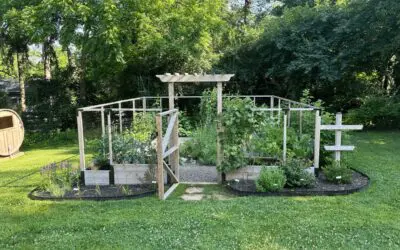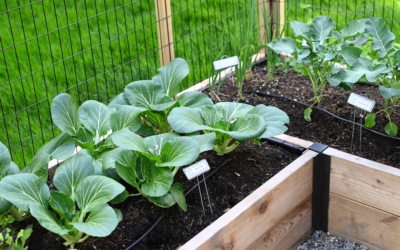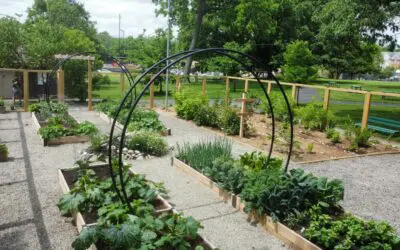Crafting your dream garden starts with choosing the perfect location. The right location can make all the difference in achieving an abundant harvest and delightful gardening experience. Let’s explore five essential factors to consider when finding the ideal spot for your raised bed vegetable garden.
Step 1: Conducting a Garden Site Survey
Finding the right location for a garden space can feel overwhelming and confusing. Before you start gathering supplies and building, don’t forget to conduct a site survey of your home, school, or community space. Surveying your property will reveal its unique characteristics and potential for growth.
There are five factors we consider necessary when designing a garden: sun exposure, water, location, visibility, and accessibility. Begin by assuming that everywhere on your property could grow something. Then, eliminate sections of your property based on your assessment of those five factors.
Some factors, like sunlight, are crucial for plant health, while others, like visibility, depend on personal preference. Understanding the significance of each factor will empower you to make informed decisions that align with your gardening goals.
Step 2: Harnessing the Power of Sunlight and Shade
Sun is the driving force of energy behind all plant production. It is the most essential element for a successful gardening experience. You can bring water to a garden, add a pathway, or even build a garden on a slope. Except for maybe chopping down a tree, you cannot typically create more sun.
If possible, build your garden in an area that gets 6+ hours of full sun in summer. This will provide the greatest success and open a wide world of growing possibilities – especially for crops like tomatoes, peppers, and squash. If your landscape has 4-6 hours of sun, you will probably experience mixed or limited success with bigger fruiting plants and should stick to greens, herbs and smaller fruiting plants like cherry tomatoes. In heavily shaded gardens, we recommend planting herbs and greens only. You will be happier with a few plants that do well, instead of a varied garden full of struggling plants.
When considering sunlight, monitor your garden area from multiple angles and times of day. Large trees provide obvious shade, but so will younger trees as they continue to grow. The same site that gets 10 hours of sun in the summer may get none in spring as the sun falls lower in the sky, maybe behind a house. By choosing sunny spots wisely, you set the stage to enjoy bountiful and diverse harvests in spring, summer, and fall.
Step 3: Navigating Groundwater Dynamics
Water is essential for sustaining life, but its presence in the wrong places can pose challenges for your garden. Take proactive steps to avoid running and standing water when choosing a location for your garden, as they can impact soil saturation and plant health.
Running water is water that flows along the ground, often during a storm. Running water has the power to wash away soil, mulch, pathways, or other features. It can also over-saturate raised beds. Standing water is any area of pooling or stagnant water that collects after rain or nearby sources of water. Standing water can “wick up” growing beds like a sponge and saturate the growing space. This will cause inconsistent and unpredictable moisture in parts of the garden, limiting the ability of seeds to germinate and thrive.
The best time to observe how water behaves on your property is during a heavy storm. Keep an eye out for gullies that carry stormwater during a rain, low points with puddles or dead grass, and runoff from hardscaping and walkways. By anticipating and mitigating potential water-related issues, you create an environment where your garden can flourish stress-free.
Step 4: Balancing Practicality and Aesthetics
Imagine gazing out your window and being greeted by a picturesque garden oasis. Choose a visible location to enhance your property’s aesthetic appeal and encourage regular interaction with your garden. Ideally, your garden will become naturally integrated into your daily life. “Out of sight, out of mind” is a real phenomenon. People are less likely to interact with their garden if it’s not readily visible. Whether you’re harvesting fresh produce for meals or simply admiring nature’s beauty, don’t miss this opportunity to enjoy magic of homegrown food
Ask yourself these questions to understand how you will interact with your garden: How often do I visit this space in my yard? What rooms in my house face the garden? Which door do I use to enter the house?
Placing your garden near frequently used entrances, such as the kitchen or back door, can also streamline tasks like harvesting and watering. This strategic positioning makes gardening a seamless part of your daily routine!
Step 5: Prioritizing Accessibility and Convenience
Accessibility is key to unlocking your garden’s full potential. A garden that’s easily reached and visible from your home invites frequent visits and effortless maintenance. Building on flat ground, in an accessible and visible area, generally provides the best experience.
Stairs and uneven terrain all pose safety concerns during construction and will continue to make daily maintenance complicated and frustrating. For example, a garden built into a slope might require installing a ramp or steps to access the garden easily and safely and make it hard to maintain.
To ensure that everyone can enjoy your garden easily, keep pathways clear and terrain manageable in dry and wet weather. Examples of rough terrain include mud and rocks. Ideally you should be able to visit your garden in bare feet. While you can install pathways to and from your garden, building a garden shouldn’t disrupt your landscape, and visiting your garden shouldn’t feel treacherous.
In conclusion, planning a raised bed vegetable garden is a journey tailored to your unique landscape. By considering factors like sunlight, water, location, visibility, and accessibility, you pave the way for a flourishing garden teeming with life and vitality. So roll up your sleeves and take the next step towards a successful garden!



